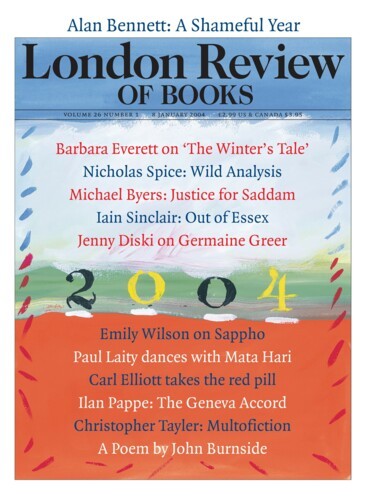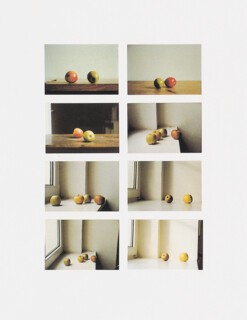Gerhard Richter ’s Atlas is on show until 14 March. The walls of the gallery are closely tiled with groups of framed cards of a couple of standard sizes. On them are mounted photographs, drawings, sketches and cuttings, mostly in rows like the illustrations in an encyclopedia of garden plants. These panels constitute an archive, displayed more or less in chronological order, of the sources of Richter’s work, from 1962 to the present. The most common primary unit is a colour print of the kind you get from your local photo shop. Groups of almost identical snaps of a single subject (a burnt-out house, a sunset, a bunch of flowers, a woman, a baby, trains on the same stretch of line, mountain landscapes, a fire) are mounted together. Some, set close to one another, make complete fields of colour, others are spaced out. On the gallery walls this flow of colour is interspersed with groups of black and white images.
The first group consists of family snapshots from the first half of the last century, little deckle-edged album pictures of the kind most people have stuffed into an envelope or shoe box at the back of a drawer. Then there are panels of magazine cuttings: illustrations of scenes in concentration camps, piles of corpses and hangings. There are pornographic pictures. There are panels with dozens of identically framed heads of famous men from an encyclopedia, others with aerial photographs of cities. There are photographs taken in Stammheim prison after the suicides of Andreas Baader, Ulrike Meinhof and Gudrun Ensslin – the images from which the paintings in the series October 18, 1977 were made (Peter Wollen wrote about them in the LRB of 5 April 2001). Some of the images are out of focus; a few have had grids drawn over them or been extended: indications that they are the source for a painting on canvas.
Also at the Whitechapel, mostly hung away from the panels on screens, are 11 of Richter’s paintings, the earliest from 1966, the most recent from 1999. Among them is an air-brush-smooth picture of a photograph of a young woman which, being lens-based, has some of the decorum and impersonality of surface cherished in Vermeer’s paintings. There is a group of panels called Eighteen Colours, each lacquered in a different shade, all as perfectly bright and glossy as new cars; there is an abstract which represents (but is not made up of) free, expressionist brush strokes – a picture of a picture. There is a group of more than life-size portrait photographs of famous men, arranged rather as they are in one of the Atlas panels.
The pictures, then, appear to be of very different kinds, but the differences mask an essential similarity. Richter has substituted for the problem ‘how do I make appropriate, personal marks (which may or may not offer an image of the world)?’ another, newer problem: ‘how do I choose significant items from the inchoate mass of images which demand attention on pages, screens and walls?’ Atlas amounts to a first sorting of the look of the world as it impinges on him.
For Richter, it seems, the painter’s task is to interrupt this flow of images and to accord samples from it the significance which attaches to artworks. He chooses what seems banal – the passing train, the misty mountain – or is taboo and then makes a picture of the image. Sometimes he blurs, or enlarges it, or makes grey what was coloured. These interventions buffer the over-quick reactions commercial imagery has conditioned us to. It means that he is able, in the case of October 18, 1977, to make political pictures which are not political slogans: the pictures make you think, but do not tell you what to think. Some material is too insistent on its role as evidence; at one time Richter thought of making paintings from the concentration camp pictures; it didn’t work and I am not surprised. Since then, he has found a way of delivering strong subject matter in homeopathic doses. The implication is that art is easily overwhelmed by its subject matter, that good cathartic visual art is rare.
Atlas makes you think about other assemblages of preparatory material. In the history of art they are the rule rather than the exception. Some painters put what they saw down on canvas while it was still in front of them, but more commonly, what was taken from life, even by landscape painters, was processed and shaped. History painters acquired rich collections of props and references. Rubens’s drawings of other men’s paintings, animals, clothes, farm carts and plants are fine, accurate observations, quite unlike the other kind of preparatory drawing he made: composition sketches in which slashed pen lines show how, in the painting, a vortex of bodies will twist and fall. In these the imagination invents the rhythms to which the observed details will give a solid presence.
Photography unsettled that way of working. Artists began to slot photographs into the picture-building process. The camera was insidious. It started by showing correct leg positions for a running horse and finished up making the whole traditional repertoire of gesture – from the portrait pose to the falling hero – seem false. But as well as showing what had been falsely represented, photographs showed what had never been noticed, or, if noticed, had been turned away from. Francis Bacon, who based pictures on Muybridge’s studies of men wrestling, also used illustrations from a book about diseases of the mouth, but his pictures are still painterly, and the quality of the marks is personal. Pop art borrowed another set of non-art images – commercial graphics – and along with them adopted the drawing style of the comic book, the painting style of the bill-board artist, the artefacts of the photocopy and the silk-screen print. But where Pop art asserts that commercial imagery is weakened when absorbed into a tradition of nuanced marks, that gloss and brashness are what make painting exciting, Richter keeps painting subtle.
When he chooses to use artless images (a photograph, a press cutting, a paint manufacturer’s sample) Richter evades one dead-end – the road blocked off by photography itself – and shows that enlarged, blurred versions of photographs can take on the significance of gallery art. In an analogous move, he avoids the dead-end deal forced on abstract painters in the 1950s: the deal that said painters may offer a body of work which is weighted with personal expression and suggests deep, if undefined, significance, but only if each of them sticks to a single kind of mark – dribbled loops, blurred rectangles, stains flowing into raw canvas and so on. What Richter’s lacquered panels seem to say is: ‘I have noticed that paint samples can be enlarged so that they are no longer about what shade to paint the bathroom, but address questions about the absolute power of colours in juxtaposition to delight and impress.’ He makes no claim for the painter’s role as dancer-with-brush, only for his ability to notice.
Richter’s campaign has, in many ways, been successful. It is not absurd to say that the pictures in the October 18, 1977 sequence evoke emotions which are as hard to put into words as those evoked by, say, Titian’s Flaying of Marsyas. To acknowledge that is to raise the question of what, apart from making an affecting image, painting can be about. Why would you travel much further than to Whitechapel to see the Marsyas? Richter has avoided dead-ends, but the road he has opened up can seem barren, the way ahead uninviting.
Send Letters To:
The Editor
London Review of Books,
28 Little Russell Street
London, WC1A 2HN
letters@lrb.co.uk
Please include name, address, and a telephone number.


